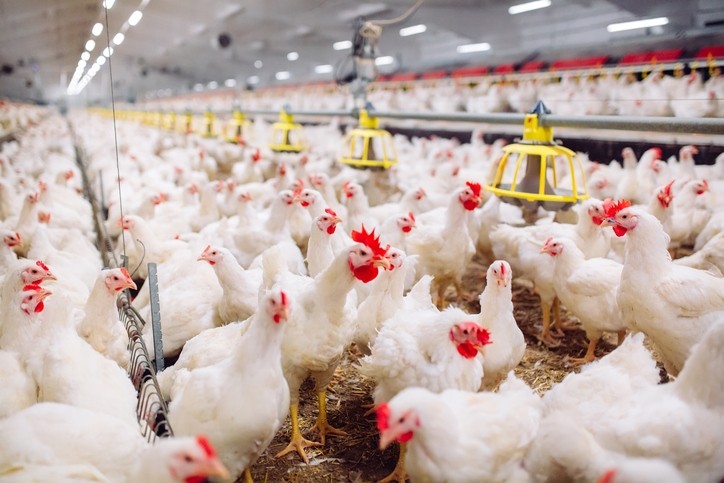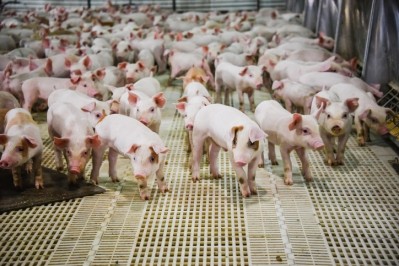ADM looks to ease poultry farming cost, sustainability challenges

Jose Charal, technical support manager, and Mohamad Mortada, research scientist in monogastric nutrition, ADM, presented on the company’s latest findings into the benefits of phytase supplementation for broiler diets, at IPPE in Atlanta last month.
ADM's bacterial 6-phytase, part of its animal nutrition line's Empirical enzyme portfolio, is designed to better utilize phytate-bound phosphorus present in plant-based ingredients.
The company’s phytase research efforts reflect current market needs, said Charal.
The team is continuously looking to improve the utilization of phytase, to adapt dosage levels, based on specific diets. “It depends on the substrates being used, and the parameters a customer is looking to meet, whether that is performance related or whether it is more about supporting bone mineralization, or other production goals,” said Mortada.
Matrix values
Essentially, the ADM team wants to ensure its nutrient matrix values for enzymes are robust. Such data has the potential to help producers to optimize diets for poultry and, in doing so, reduce the cost of feed.
While phosphorus is present in plant ingredients in quantities sufficient to maintain good levels of animal performance, much of it is the form of phytic acid, and is largely unavailable to monogastric animals because they lack the phytase enzymes required to release the phosphorus from the acid. Consequently, a great part of the phosphorus naturally present in the diet of monogastric animals is excreted undigested. This limits animal performance and creates environmental problems, particularly freshwater pollution.
Phytases are digestive enzymes that hydrolyze and release the phosphate groups from the phytic acid, making the phosphorus available to the animal. Phytase’s ability to hydrolyze the acid enhances energy and protein utilization, helping to improve growth and FCR, while reducing nitrogen pollution.
The results of one of the recent studies the team conducted, showed that, even at doses as low as 500 FTU/g, the bacterial 6-phytase can support the growth of broiler chickens, thereby reducing the need for the addition of inorganic phosphorus, while lowering feed costs and reducing phosphorus excretion into the environment, said Mortada.
That work showed the effectiveness of phytase supplementation at 500, 1,000, or 1,500 FTU/kg inclusion rates on body weight gain and feed intake, he added, noting that these kinds of insights are critical, particularly as superdosing of phytase is gaining traction.
Charal, in conjunction with researchers at Virgina Tech, also analyzed the effect of ADM’s bacterial 6-phytase on recovery in feed and performance, bone mineralization and calcium and phosphorus apparent ileal digestibility in 21-day-old broilers in combination with a direct fed microbial (DFM) and a xylanase.
Phytase, at an inclusion level of 750 FTU/kg, was able to restore performance and increase both ileal phosphorus digestibly and apparent metabolizable energy (AMEn) in reduced nutrient diets, but the researchers observed that additional feed additive supplementation – an NSP enzyme - was required to fully restore dietary AMEn, explained Charal.
Thermostability
Along with those insights in relation to feed efficiency, ROI and more sustainable broiler production, the ADM team set about evaluating the robustness of the bacterial 6-phytase under feed processing conditions, given that producers, particularly in the US, are increasing their pelleting temperatures to reduce the pathogenic load in poultry feed.
The market wants to know whether enzymes really work at high temperatures, said Mortada.
The research findings demonstrated that the phytase is highly thermostable with no reduction in phytase activity after exposure to the various pelleting steps. “We could reach around 175 degrees Fahrenheit ± 2 degrees, as a range, and we saw that its thermostability and recovery in feed is actually between 74 and 91%.”
That study was run at pilot scale. “We now intend to test our phytase at higher temperatures and to evaluate it under commercial scale pelleting conditions.”
The team will take advantage of ADM’s newly acquired Montgomery Research Center to do so, said Mortada.
In addition, ADM’s researchers will dig deeper into the potential effects of the superdosing phytase trend. The benefits can be considerable, and often beyond that which may be reasonably expected based on improvement in phosphorus digestibility, he added.







